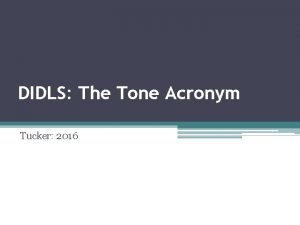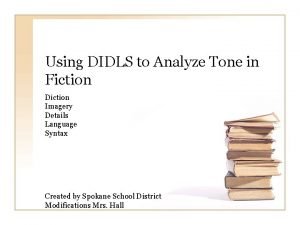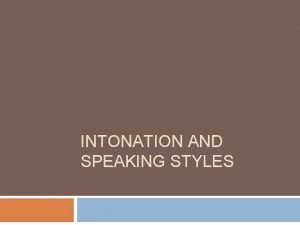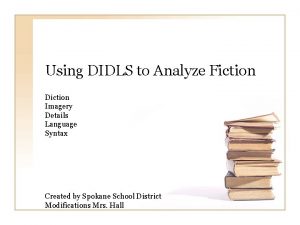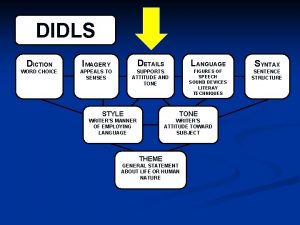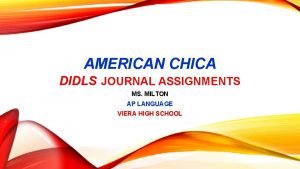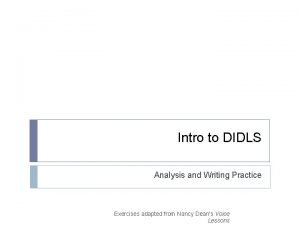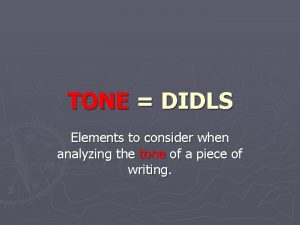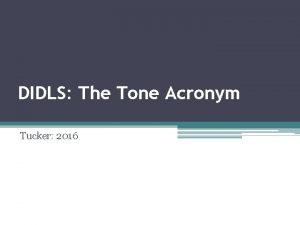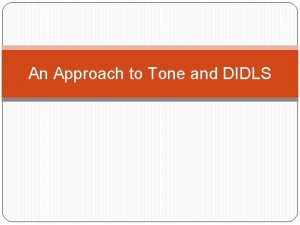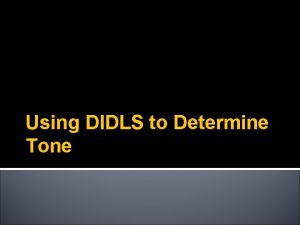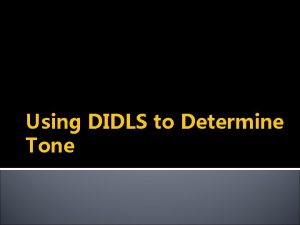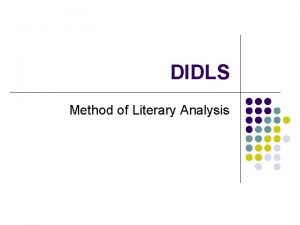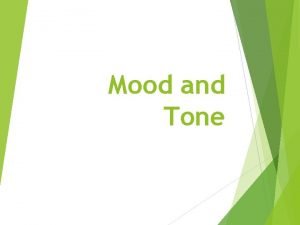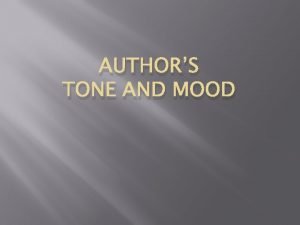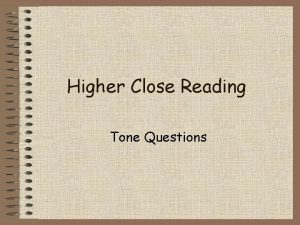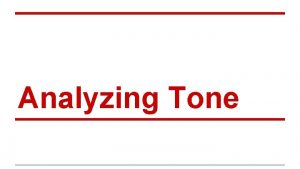DIDLS The Tone Acronym Tucker 2016 What is











- Slides: 11

DIDLS: The Tone Acronym Tucker: 2016

What is DIDLS? • DIDLS is a method of analyzing author’s style and tone through the following elements: 1. Diction 2. Imagery 3. Details 4. Language 5. Syntax

Diction • Diction - the connotation of the word choice • The meaning suggested by a word; or a word’s power to produce a strong reaction in the reader. • What words does the author choose? Why did the author choose those particular word(s)? ▫ Ex. thin vs. gaunt; muscular vs. husky ▫ Ex. happy vs. ecstatic ▫ Ex. Joel was dumb vs. Joe was a primate with a brain the size of a pea.

Imagery • Imagery - vivid appeals to understanding through the senses • Imagery may be defined as an author’s use of words and phrases that appeal to the five senses. • The use of vivid descriptions or figures of speech helps to create the author’s tone. • What images does the author use and why does he/she focus on in a sensory way? ▫ Ex. Laughing, the boy fell dead. (shocking) ▫ Ex. The clouds hung oppressively low in the heavens. (darkness and loneliness)

Details • Details - facts that are included or those that are omitted • Details are most commonly the facts given by the author or speaker as support for the attitude or tone. Look closely at what an author may include or leave out. Consider what the author’s details reveal about the overall tone of the piece. • What details does the author choose to include or exclude, and what do they imply? ▫ Ex. An author may describe a bloody crime scene with details about the “stench of rotting bodies, ” but another might say that the victims were murdered.

Language • Language - the overall use of language, such as formal, clinical, or jargon • The language of a passage has control over tone. • What the language the author uses convey? • What is the overall impression of the language? ▫ Ex. An invitation to a wedding might use formal language, while a biology textbook would use scientific language.

Sentence Structure • Sentence Structure - how structure affects the reader’s attitude • Sentence structure affects tone and what the reader understands. • What are the sentences like? Are they simple, complex, choppy, flowing etc. ? ▫ Ex. Long, flowing sentences provide a different feeling than short, choppy ones.

“My Papa’s Waltz” • Read annotate the poem. Make connections, ask questions, note the following: ▫ ▫ ▫ Diction Imagery Language Poetic devices Format/Structure • Establish the tone of the poem based on the diction. • Circle words/phrases that help establish the tone.

Paragraph • Write a paragraph analyzing how the diction in the poem provides 2 different interpretations of the poem. ▫ Topic sentence: author and “title” and topic ▫ Discuss 2 possible interpretations of the poem ▫ Textual evidence for each interpretation Lead in to quotes properly: Says Sentence blended ▫ Explain evidence and connect to topic. An example of how the diction conveys the first interpretation is… ▫ Conclude paragraph properly

“Mutability” Wordsworth vs. Shelley • Diction: Highlight interesting word choices that help to establish tone/meaning (annotate) • Imagery: Highlight examples of imagery that support the tone/meaning (annotate); label what they are (i. e. simile, metaphor, etc. ) • Details: Underline specific details in each that make each poem unique (especially since they both share the same theme) • Structure: Look at the poetic structure of each poem and annotate their differences (rhyme scheme, stanzas, type of poem, syntax, parallel structure).

After reading and annotating: Complete the following: • Write an introductory paragraph as if you were going to compare and contrast the 2 versions of “Mutability”. Your thesis needs to include 2 of the DIDS elements you annotated as well as their purpose (what those elements help to create/establish in the poem). Remember: ▫ Titles and authors of both poems ▫ Present tense ▫ Description of each poem and the common theme ▫ Elevate your own syntax and diction ▫ Thesis is the LAST sentence in your paragraph.
